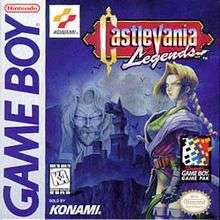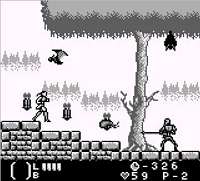Castlevania Legends
| Castlevania Legends | |
|---|---|
 North American box art | |
| Developer(s) | Konami Computer Entertainment Nagoya |
| Publisher(s) | Konami |
| Director(s) | Kouki Yamashita |
| Designer(s) | Tsukasa Hiyoshi |
| Programmer(s) | Yoshiteru Yamaguchi |
| Artist(s) | Kazunobu Uchida |
| Composer(s) |
Kaoru Okada Youichi Iwata |
| Series | Castlevania |
| Platform(s) | Game Boy |
| Release | |
| Genre(s) | Platforming |
| Mode(s) | Single-player |
Castlevania Legends[lower-alpha 1] is the third Castlevania title released for the original Game Boy. It was released in Japan on November 27, 1997 and in North America on March 11, 1998.
Gameplay

A player starts with three lives, after which the game is over. A player may continue from the beginning of the last stage they were in.[1] There is also a Hit score showing how many enemies have been defeated in each stage.[1] Like other Castlevania games, striking candles will cause items to appear.[1] However, unlike most other Castlevania titles, the traditional subweapons are replaced with five unique magic spells called "Soul Weapons".[2] Hearts are used as currency to acquire weapons.[2] Sonia can also enter a "Burning Mode", where she becomes invincible, moves faster, and has more powerful attacks, though this power can only be used once per life or level.[2]
Plot
The story begins in Transylvania in the year 1450. In the game (although not the series' overall canon), Sonia Belmont is the first Belmont to confront Dracula.[1][2] She also meets Alucard who seeks revenge against his father Dracula.[2][3] After Dracula's defeat, he swears to Sonia that as long as there is evil in the world, he will be resurrected, and in response she swears her family will always defeat him.[2] The game was also the first game in the series timeline until Lament of Innocence, and was later designated as non-canon.[2]
Reception
IGN called the game one of the Game Boy's cult classics despite the portable system's limitations.[2] GameSpy called the music "disappointing", as the previous two Game Boy Castlevania games were highly praised for their music.[4] Game Informer's Tim Turi felt that the game was lacking especially compared to Castlevania: Symphony of the Night.[5]
Longtime Castlevania producer Koji Igarashi removed the game from the series timeline, claiming that in his opinion it conflicted with the plotline of the main games.[6] He has stated that "Legends remains something of an embarrassment for the series. If only that development team had the guidance of the original team of the series."[7]
Other media
Sonia was one of the confirmed leads in the Dreamcast game Castlevania: Resurrection, up until that game's cancellation.[8]
Notes
- ↑ Known in Japan as Akumajō Dracula: Dark Night Prelude (悪魔城ドラキュラ
漆黒たる前奏曲 Akumajō Dorakyura Dāku Naito Pureryūdo, lit. Devil's Castle Dracula: Dark Night Prelude)
References
- 1 2 3 4 Castlevania Legends Instruction Booklet. Konami. 1989. p. 16. DMG-ADNE-USA.
- 1 2 3 4 5 6 7 8 Mark Bozon (2007-01-18). "Castlevania: The Retrospective". IGN. Retrieved 2008-07-13.
- ↑ "Castlevania Legends (1998)". GameSpy. 2000-01-01. Retrieved 2008-07-13.
- ↑ "The Music of Castlevania Legends". GameSpy. 2000-01-01. Retrieved 2008-07-13.
- ↑ Turi, Tim (2012-04-04). "Ranking The Castlevania Bloodline". Game Informer. Retrieved 2013-12-05.
- ↑ Kurt Kalata (2006-07-26). "Tales from the Crypt: Castlevania's 20th Anniversary Blow-out". 1UP.com. Archived from the original on 2016-09-14.
- ↑ Nintendo Power, August 2008
- ↑ "Castlevania Resurrection." IGN.com. 2007. IGN Entertainment Inc. 21 June 2007. <http://dreamcast.ign.com/objects/012/012004.html>